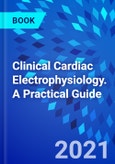- Focuses on using an effective, consistent, decision-making process in recognizing, diagnosing, and treating rhythm disturbances of the heart, including supraventricular tachycardias, atrial fibrillation, ventricular tachycardias, and other rapid or irregular heartbeats.
- Covers anatomic fundamentals of cardiac structures, clinical indications for electrophysiology studies, practicalities and methodology of performing an electrophysiology study, and problems encountered during the procedure.
- Includes quick clinical summaries and more than 180 illustrations: electrophysiology recordings, ECGs, cardiac anatomy, radiographic images, and electroanatomic maps.
- Discusses key topics such as mechanisms of arrhythmias, conventional and electroanatomic mapping systems, fundamentals of cardiac mapping, biophysics of catheter ablation, and much more.
- Offers real-world guidance on contemporary practice from leading cardiac electrophysiologists Drs. Demosthenes G Katritsis and Fred Morady, with input from a multinational team of electrophysiology fellows and cardiologists.
- Ideal as a stand-alone resource or used in conjunction with Dr. Douglas Zipes' renowned textbook, Cardiac Electrophysiology: From Cell to Bedside.
- Enhanced eBook version included with purchase. Your enhanced eBook allows you to access all of the text, figures, and references from the book on a variety of devices.
Table of Contents
Chapter 1. Classification of Arrhythmias
Chapter 2. Electrophysiologic Mechanisms of Arrhythmogenesis
Chapter 3. Cardiac Anatomy for the Electrophysiologist
Chapter 4. Vascular Access and Catheters
Chapter 5. Electrophysiology Hardware
Chapter 6. Basic Intervals and Atrial and Ventricular Conduction Curves
Chapter 7. Electro-Anatomic Mapping and Robotic Navigation
Chapter 8. Physics of Ablation
Chapter 9. Investigation of Bradycardias
Chapter 10. Differential Diagnosis of Narrow-QRS Tachycardias
Chapter 11. Differential Diagnosis of Wide-QRS Tachycardias
Chapter 12. Diagnosis and Catheter Ablation of Atrial Tachycardias
Chapter 13. Diagnosis and Catheter Ablation of Atrial Fibrillation
Chapter 14. Diagnosis and Catheter Ablation of Atrioventricular Junctional Tachycardias
Chapter 15. Diagnosis and Catheter Ablation of Wolff-Parkinson-White Syndrome and Atrioventricular Tachycardias
Chapter 16. Diagnosis and Catheter Ablation of Ventricular Tachycardias
Authors
Demosthenes G Katritsis Director, Department of Cardiology, Hygeia Hospital, Athens, Greece; Honorary Consultant Cardiologist, St Thomas HospitalLondon, UK; Adjunct Assistant Professor of Cardiology, Johns Hopkins University School of Medicine, Baltimore, Maryland, USA. Demosthenes G Katritsis, MD, PhD, is a pre-eminent international figure in cardiology. He heads the Heart Center and is Director of Advanced Interventional Cardiology and Electrophysiology and Clinical Cardiologist at Hygeia Hospital Heart in Athens, Greece. Dr Katritsis is also Honorary Consultant Cardiologist at St Thomas Hospital in London. He has published over 300 articles and coauthored several European and US textbooks of clinical cardiology, including (with John Camm) Clinical Cardiology: Current Practice Guidelines and is currently editor-in-chief of the journal Arrhythmia and Electrophysiology Review afflilated with the European Heart Rhythm Association (EHRA) and co-chair of selected guidelines for the European Society of Cardiology (ESC). Fred Morady McKay Professor of Cardiovascular Disease, Professor of Medicine, University of Michigan Medical School, Ann Arbor, Michigan. Fred Morady, MD, McKay Professor of Cardiovascular Disease and Professor of Internal Medicine at the University of Michigan Medical School in Ann Arbor, Michigan, is equally esteemed in the field of cardiology.








